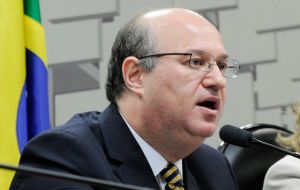MercoPress. South Atlantic News Agency
Brazil cuts Selic rate to 10.25%, lowest since December 2013: slowing inflation and gradual recovery
 The Central Bank Copom states that it was unanimously decided to reduce the Selic rate by one percentage point, to 10.25% per year, without bias
The Central Bank Copom states that it was unanimously decided to reduce the Selic rate by one percentage point, to 10.25% per year, without bias  Governor Ilan Goldfajn said the scenario assumes a path for the policy interest rate that ends 2017 at 8.5% and remains at that level until the end of 2018
Governor Ilan Goldfajn said the scenario assumes a path for the policy interest rate that ends 2017 at 8.5% and remains at that level until the end of 2018  Stronger global economic activity has so far mitigated the effects on the Brazilian economy of possible changes of economic policy in central economies
Stronger global economic activity has so far mitigated the effects on the Brazilian economy of possible changes of economic policy in central economies The Central Bank of Brazil unanimously cut its key Selic rate by 100 basis points to 10.25 percent on Wednesday May 31st of 2017, as widely anticipated. It is the sixth straight rate decline, bringing borrowing costs to the lowest since December of 2013 amid slowing inflation and a gradual recovery.
Wednesday's decision follows a 100 bps cut in the April 12th of 2017 meeting. Interest Rate in Brazil averaged 15.59% from 1999 until 2017, reaching an all time high of 45% in March of 1999 and a record low of 7.25% in October of 2012.
The Central Bank Copom states that it was unanimously decided to reduce the Selic rate by one percentage point, to 10.25% per year, without bias. The following observations provide an update of the Copom’s baseline scenario:
The set of indicators of economic activity released since the last Copom meeting remains consistent with stabilization of the Brazilian economy in the short run and a gradual recovery during the course of the year. If sustained over long period, high levels of uncertainty regarding the evolution of reforms and adjustments in the economy can have detrimental effects on economic activity;
Stronger global economic activity has so far mitigated the effects on the Brazilian economy of possible changes of economic policy in central economies;
Inflation developments remain favorable. Disinflation is widespread and includes IPCA components that are most sensitive to the business cycle and monetary policy. It is necessary to monitor possible impacts of higher uncertainty on the prospective path of inflation;
Inflation expectations for 2017 collected by the Focus survey fell to around 4.0%. Expectations for 2018 are around 4.4%, and expectations for 2019 and longer horizons are around 4.25%;
Copom’s inflation projections for 2017 and 2018 in the scenario with interest rate and exchange rate paths extracted from the Focus survey are around 4.0% and 4.6%, respectively. This scenario assumes a path for the policy interest rate that ends 2017 at 8.5% and remains at that level until the end of 2018. The Committee emphasizes that its conditional inflation forecasts currently involve a higher level of uncertainty.
The Committee views the heightened uncertainty regarding the speed of the process of reforms and adjustments in the Brazilian economy as the main risk factor. This arises from both a higher probability of scenarios that may hinder this process, and the difficulty in assessing the effects of these scenarios on the determinants of inflation.
Taking into account the baseline scenario, the balance of risks, and the wide array of available information, the Copom unanimously decided to reduce the Selic rate by one percentage point, to 10.25% per year, without bias. The Committee judges that convergence of inflation to the 4.5% target over the relevant horizon for the conduct of monetary policy, which includes 2017 and, to a greater extent, 2018, is compatible with the monetary easing process.
The Copom emphasizes that the extension of the monetary easing cycle will depend, among other factors, on estimates of the structural interest rate of the Brazilian economy. The Committee judges that the recent increase in the uncertainty regarding the evolution of reforms and adjustments in the economy hampers a more timely reduction of estimates of the structural interest rate, and makes them more uncertain. The Committee will continue to reassess these estimates over time.
In light of the basic scenario and current balance of risks, the Copom judges that a moderate reduction of the pace of monetary easing relative to the pace adopted today is likely to be appropriate at its next meeting. Naturally, the pace of monetary easing will continue to depend on the evolution of economic activity, the balance of risks, possible reassessments of the extension of the cycle, and on inflation forecasts and expectations.
The following members of the Committee voted for this decision: Ilan Goldfajn (Governor), Anthero de Moraes Meirelles, Carlos Viana de Carvalho, Isaac Sidney Menezes Ferreira, Luiz Edson Feltrim, Otávio Ribeiro Damaso, Reinaldo Le Grazie, Sidnei Corrêa Marques, and Tiago Couto Berriel.




Top Comments
Disclaimer & comment rules-

-

-

Read all commentsStill A Mess: http://google.com/newsstand/s/CBIwuYWBgDU
May 31st, 2017 - 11:49 pm 0One thing most people - and especially those who are NOW going to demonstrations to protest against the SELIC rate, currently at 10.25% - don't realize, is that :
Jun 01st, 2017 - 06:23 pm 01) during Dilma's terms, the SELIC rate reached it's highest level in recent years (as part of her failed strategy to control inflation), and no-one, especially the PT, the unions and the 'lefties' in general, complained....far less, protested.
2) While what happens to the SELIC rate (going up, or down) has virtually no influence on prices to the consumer , it does affect the remuneration of certain funds, the investments of which have a heavy concentration on governernment bonds and inter-banking deposits...
3) Further to (2) if you analyse the historic performance of the SELIC, you will notice its reduction has little or NO effect on the interest rates that the market in general pays...such as on outstanding debt on a checking account, on credit cards - varying from 400% to 500% a year - on certain types of bank loans, such as for real estate purchases, vehicles, and even personal loans, usually over 100% a year....which on top of it, still require 'guarantees'...
So, it would seem to me that the protesters are misdirecting their complaints....they should go after the banks as well, which charge these exhorbitant rates regardless of what happens with the SELIC rate, because the government is in cahoots with them...
The reduction in the SELIC rate benefits business, which are eligible for gigantic loans at very low interest rates (good example the J&F conglomerate - JBS), but has hardly any effect on the daily activities of consumers, or on the man in the street.
I'd like to understand the following:
Jun 02nd, 2017 - 01:20 am 0On one hand, all the Investigations & the Operation are [apparently] relentlessly being carried out because The Law is ONE and is Equal; for ALL the citizens REF: [https://www.humorpolitico.com.br/wp-content/uploads/2017/06/elvis-580x290.jpg ] .
While on the Other Hand; the “Special Privileges” and “More Favorable Laws” [practicaly a NEW constitution] are on the anvil, READY to be granted! HOW COME?
Commenting for this story is now closed.
If you have a Facebook account, become a fan and comment on our Facebook Page!